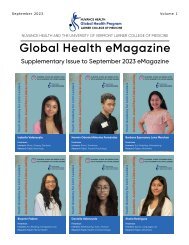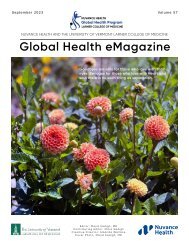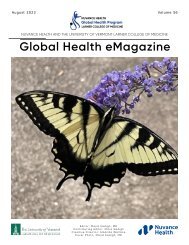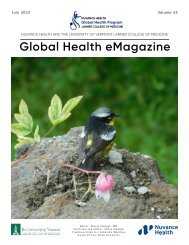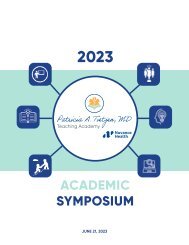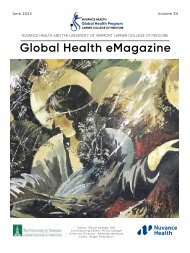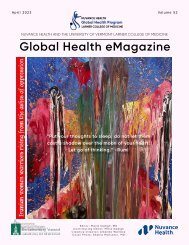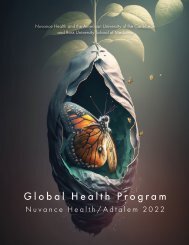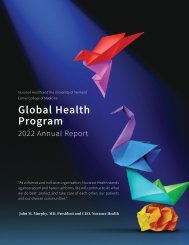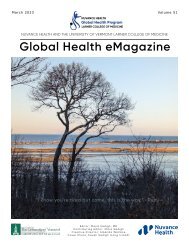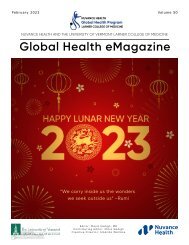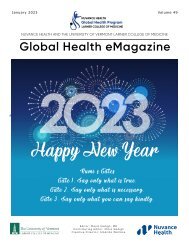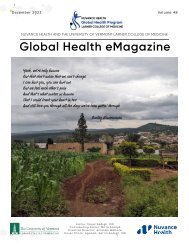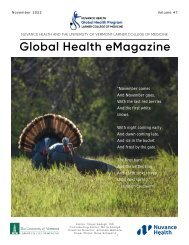April_eMagazine Volume 40
Create successful ePaper yourself
Turn your PDF publications into a flip-book with our unique Google optimized e-Paper software.
OUR PEOPLE,<br />
OUR MISSION<br />
Global Health<br />
<strong>eMagazine</strong><br />
<strong>April</strong> 2022<br />
Watch this video!!<br />
Bani Adam by Saadi Shirazi<br />
Mulago Hill, Uganda: Flight to the Moon<br />
Written by Hossein Akbarialiabad, MDMSc, Iran<br />
In Mulago Hospital’s accidents and emergency ward, the<br />
evolutionary survival of the fittest reigns. Due to the scarcity of<br />
resources, one can only hope that they will be able to extend<br />
a patient’s life until the next bottle of normal saline, the next<br />
dose of antibiotics, the next shot of insulin appears. On arrival,<br />
patients are examined by an intern or medical officer who then<br />
triages them into outpatient and red zone cases.<br />
The ongoing strike by medical professionals in Uganda against<br />
the poor pay and unfair working conditions they endure has left<br />
hospitals even more understaffed than usual. The high costs of<br />
medical care in private hospitals drive the majority who cannot<br />
afford a government-funded hospital. The promise of free<br />
services, however, is unfulfilled as the cost of tests and treatments<br />
are out-of-reach for many patients and families.<br />
Highlights<br />
Perspectives<br />
Behind the Scenes<br />
Announcements<br />
Spotlight<br />
Reflections<br />
Nursing Division<br />
SARS COV-2 Pandemic<br />
and Us<br />
Clinical Case Report<br />
The prevailing circumstances dictate that we practice medicine with extremely depleted resources<br />
and a ceaseless stream of patients, some of whom are abandoned at the entrance by their relatives<br />
out of hopeless desperation. When pushed between a rock and a hard place, you have to make<br />
decisions that only you can understand. Disease spares no one, and considers neither resource<br />
nor accessibility. The 30% mortality rate in Mulago for those in admission remains just as high after<br />
discharge, meaning the mortality risk is cumulatively 60% on arrival, regardless of cause.<br />
On this tropical November morning, in the middle of the crowded, dimly-lit emergency hall of<br />
Mulago National Referral Hospital, it was busy as usual with multiple lengthy and tasking rounds.<br />
As we completed the teaching round, a few nurses carried a pale, cold girl into the room. This was<br />
a diurnal occurrence; patients are brought into an already suffocating ward with meager resources<br />
where they continue the fight for life while medical personnel wrestle to give them the chance.<br />
At the time the little girl was brought in, we had only one patient left to end the round and were<br />
tired to the core. She was dropped off at the adjoining verandah and carried by the nurses into<br />
the emergency room. Her radial pulse was absent, with no detectable blood pressure. The only<br />
signs of life were carotid vibrations in addition to an abnormal breathing pattern. The sweet smell<br />
emanating from her mouth, coupled with the distressed breathing, are pathognomonic of diabetes<br />
mellitus.<br />
The examination revealed a Glasgow Coma Scale (GCS) level of 3/15. We immediately planned<br />
to start intravenous fluids with two liters of normal saline, which was a setback because we could<br />
A New Column<br />
Global Health and the Arts<br />
Articles of the Month<br />
Videos of the Month<br />
Calendar<br />
Resources<br />
17<br />
Spotlight continued on next page >>




